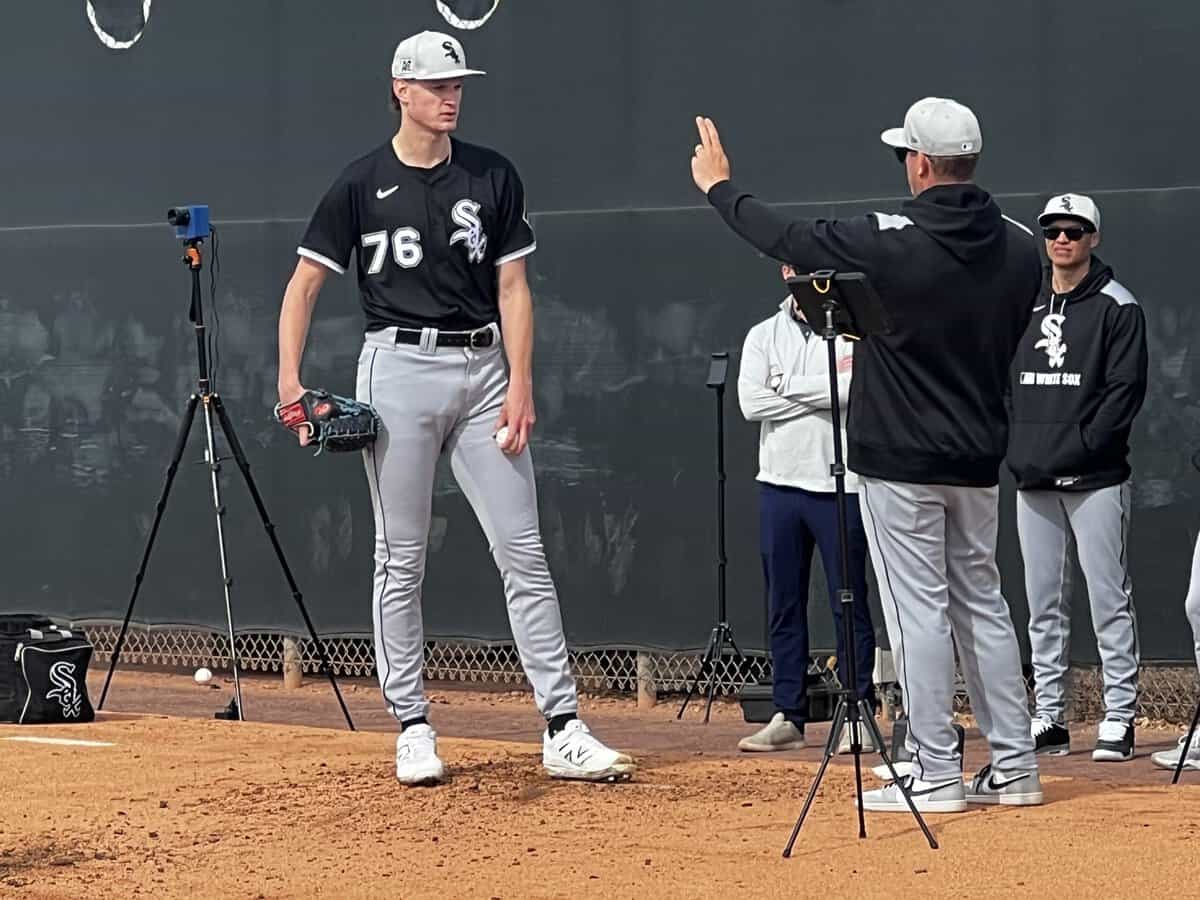PHOENIX -- There are challenges for White Sox executives when they talk about organizational improvement.
The first and most pressing issue is that the team is still bad -- at the bottom of our win cycle is a preferred description, as it reflects more intentionality in their current status -- and they don't really expect the general public to buy into what they're doing before the results indicate they should.
The second is that broad descriptions of the process can sound like a mass email from the CEO that no one actually reads. The White Sox have better "organizational synergy" and "improved inter-department communication," but who knows what that actually means, and the state of the major league roster only fuels but so much motivation to find out, cycling back to the first problem.
Moreover, the notion that the White Sox are working heartily to catch up to the rest of the league has been teased for a while now, including by the previous baseball operations regime. So it's hard to appreciate how far new team leadership has progressed without understanding where things were this time last year.
"There's just a lot of things we didn't have information-wise last year that's going to help us develop players better, more efficiently," said Brian Bannister, senior advisor to pitching. "We were less efficient with everything."
The overhaul of the international scouting department once more found the White Sox tasking new leadership with opening up access to swaths of the Latin American market to which they simply lacked access previously. But part of David Keller's work in revamping the organization's "process" was overseeing the department working on the same evaluation scale as the amateur and pro scouts, which they did not before. It's not a turnkey undertaking, as finding game action for international prospects is not as easy as it is domestically, which is why the proliferation of portable Trackman and Blast Motion units for the department takes on so much importance. More than anything, it's representation of an organization where departments were not intentionally siloed, but had not been developed to operate in coordination with each other.
For example, the White Sox obviously knew what all their minor league pitchers threw and in what areas of the strike zone it worked best, but there was no system in place to put that information on wristbands for their catchers to refer to mid-game. Hawkeye tracking systems are being installed at all the Sox affiliates for this year, the lack of which is believed to have contributed to shortcomings in evaluating and valuing defense, and responding to how other teams were attacking them. All those ads about the MLB housing Statcast on Google Cloud carried a sting, because last year the White Sox were the only one of 30 teams that did not have their data housed on it, reflective of an organization-wide issue of a clogged data pipeline.
There's a dedicated cloud engineer in place now, a new vendor contracted to help ensure data consistency throughout the organization, and the research and development team -- small but mighty -- gets referred to with such reverence because the winter has been spent forming solutions to so many weird gaps across the franchise. But after 121 losses, after years of returns from talent and investment that disappointed, these are the sort of issues White Sox leadership sees as root causes.
Maybe some of it seems basic, but there was a lot of it.
"It was an assessment period on the organization, and the assessment goes beyond just myself," said general manager Chris Getz. "To have others come in from other places and assess, and get their fresh take on how are we going to create competitive advantages? And so, that took a year. It really did. And we identified those areas, and we've improved them."
Improved, but it's quite far from completed, as they would all readily admit. It might be a closely held secret how dimly the White Sox viewed their revenue situation, were they not openly stumping for a new stadium and trotting out one of the lowest player payrolls in the sport. Coming off arguably the worst season ever with uncertainty over how much of their fan base can watch their games in television, it's at a particular low point right now. But it's not like they're preparing for the days where they're pushing into the luxury tax for top free agents.
"If we can't hang onto the premium players forever, like the [Dylan] Ceases and [Garrett] Crochets, then we just have to be better, like certain other organizations, at developing faster," Bannister said. "Getting the most out of our guys faster, and turning it over and really putting a quality product on the field that keeps up with other, more modernized organizations."
At this point, the first suggestion for where the White Sox future competitive advantage might lie with Bannister and the pitching infrastructure underneath him. Self-admittedly priced out of the top of the pitching market, the Sox have been hunting funky, unique arm actions rather than proven commodities, and hope to use seam effects to induce weak contact in lieu of the bat-missing stuff that lies beyond the budget they have been allotted. If it produces a capable pitching staff from what the industry looks at as modest ingredients, they'll have something from which to build.
And some more major league success would be welcome for everyone who went through 2024, but leadership would be remiss if they didn't acknowledge its purpose. Chicago was once prairie land, so references to cleansing wildfires come easy around these parts.
Hiring a director of hitting, buying a Trajekt machine for him and other hitting coaches to employ, and generally addressing the weakest collection of bat speed in the league like the crisis that it was, has an upfront cost. But like all the infrastructure improvement on the table, it costs less than Alex Bregman. Such a case is easier to make after 121 losses. Maybe even easier than it would have been after 115.
"I pride myself on having JUCO mindset: We might not have the fanciest equipment but we're going to beat the crap out of the teams that have every resource possible," said Ryan Fuller, aforementioned director of hitting. "But the great thing is they've made a great commitment to research and development. They have unbelievable biomechanists with the White Sox. I'm really excited to work with the tools that we have, the tools we're going to bring in and the really smart people we have."
His hire gets pointed to a lot in reference to pitch framing being another area where the White Sox are desperate to improve from bottom of the league performance, but Walker McKinven often points out that he's a bench coach now, and his responsibilities are different now than when he became renowned for overseeing pitch framing improvements with the Brewers. Just as intriguing for the Sox might be exposure to the way Milwaukee evaluates players. It won't be exactly what the White Sox wind up adopting, but a small-market team that's regularly competitive by heavily prioritizing defense is intriguing, as they are on the hunt for their own angle.
Plenty of change has come to White Sox's domestic scouting as well, and they're trying to pivot from an organization that feels they've been prone to overvaluing corner bats -- generally an overpriced and replaceable commodity -- to one that finds value on the margins; as much or more than they had been bleeding it relentlessly for years.
"There are organizations that are in the middle or even bottom-third in sprint speed, but are still net positive in creating runs based on maximizing leads and secondary [leads]," said Getz, ruminating on another facet where the White Sox were previously under-informed. "Just understanding those pieces of the game and understanding the how and knowing that we have a team in place that can go out and execute that."
"We just started with an objective approach and talking about if you want to create value for yourself and for the team, you are going to have to really cover ground and really cover the first five feet as quickly as possible," said Will Venable, recapping a recent meeting drilling home the important of pre-pitch movements and setup, another area in which the next competitive White Sox team will need to excel. "There’s a technique to it, an approach. Really kind of answering the how of going about it is what our coaches will be driving home these first couple of days."
For White Sox fans of the last decade, a team that actually excelled at this level of detail -- rather than just talked about in spring -- has been a fantasy, a standard they hoped a manager could enforce, or a veteran free-agent signing might insert via influence. Instead, a closer look has driven home how far away it had become, and a grueling path of losing, sell-off trades and staffing turnover that lay in between.
"The hard decisions were trumped by the enthusiasm of what's on the other side," Bannister said. "If there's something that's hard to do in the short-term but it's better in the long-term, just rip the Band-Aid off. I give ownership and leadership credit in that they've ripped a lot of Band-Aids off. We're much better set up to succeed going forward and having both a longer competitive window, and doing things the right way and doing things the fans can appreciate, just to ultimately put a better year over year product on the field."





